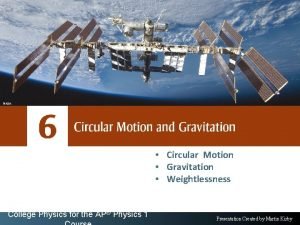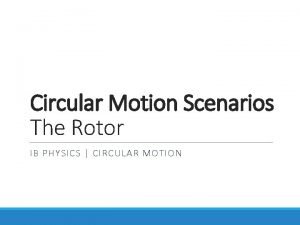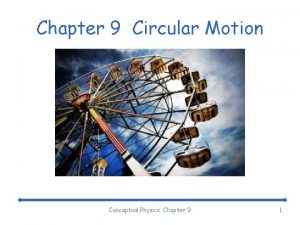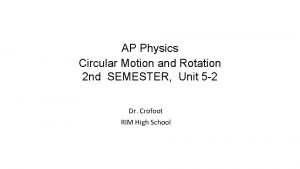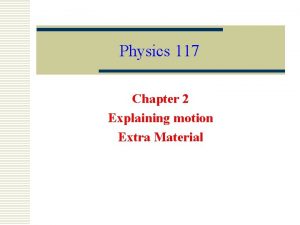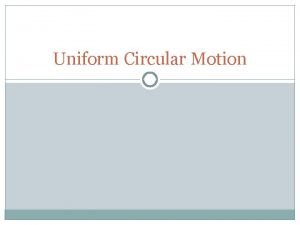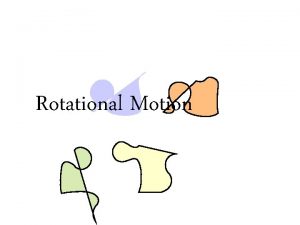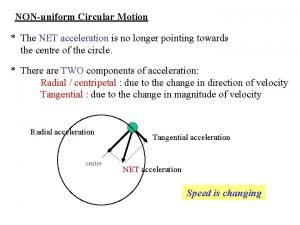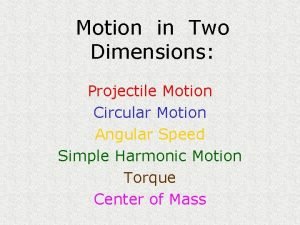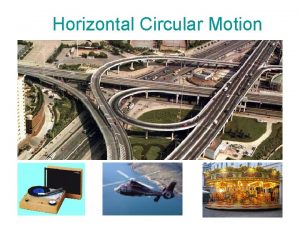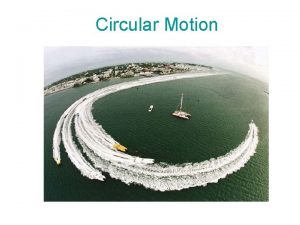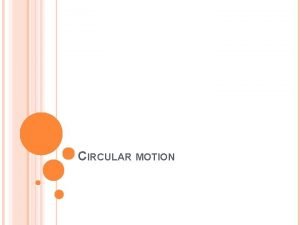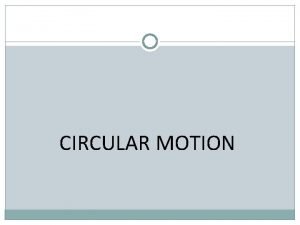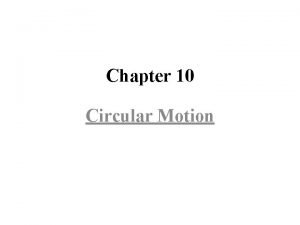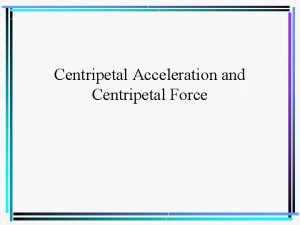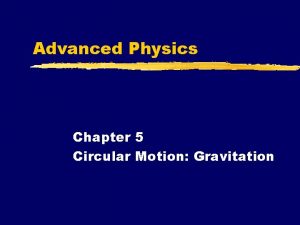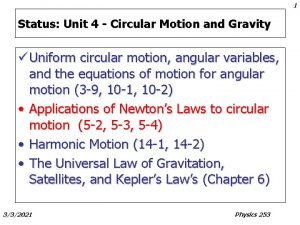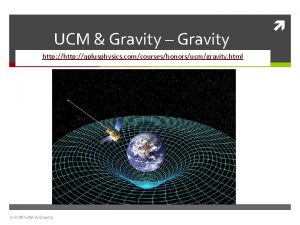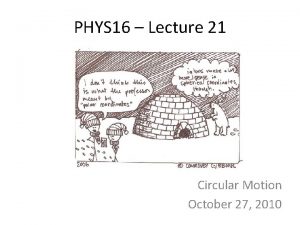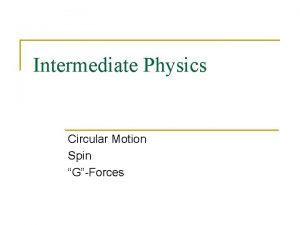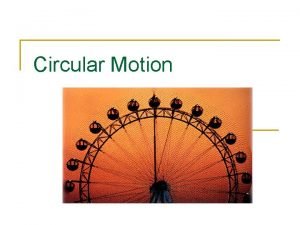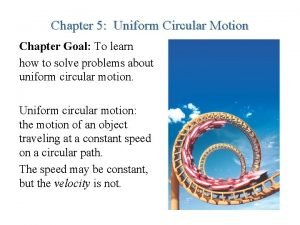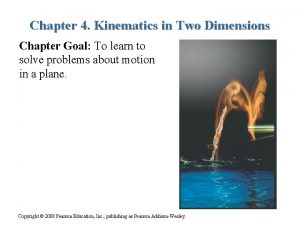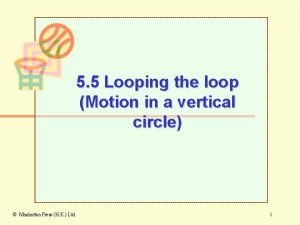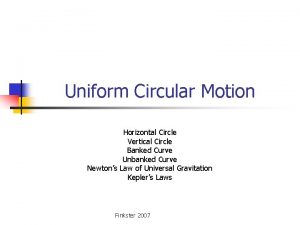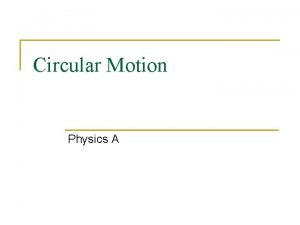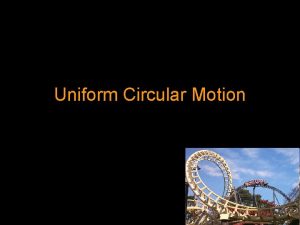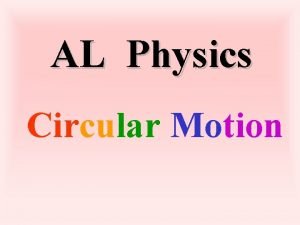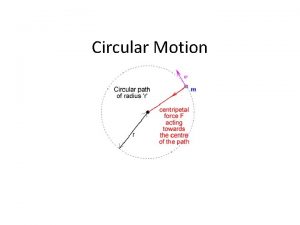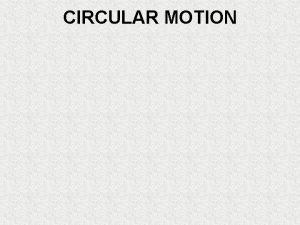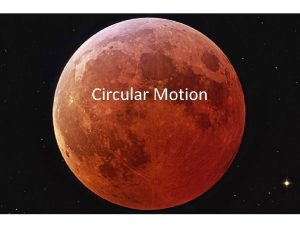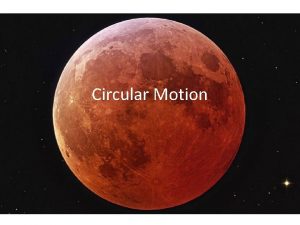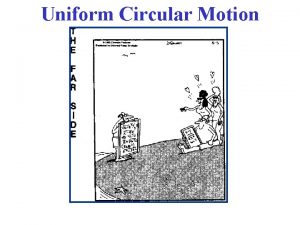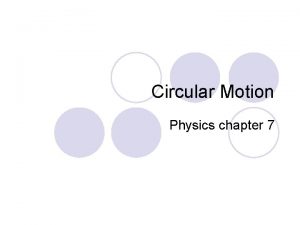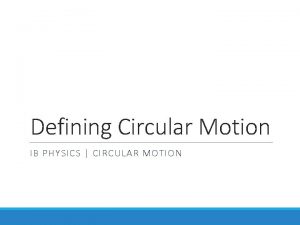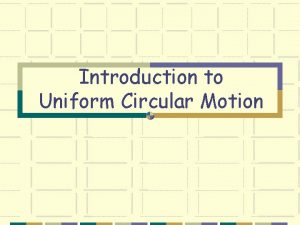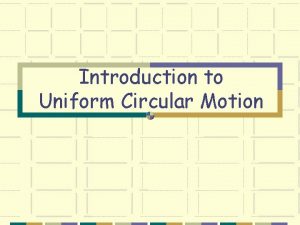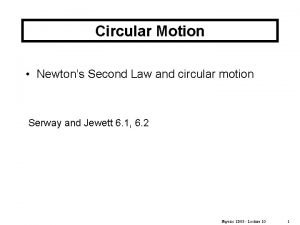Circular Motion Physics A Introduction Which moves faster




































- Slides: 36

Circular Motion Physics A

Introduction Which moves faster on a merry-go-round, a horse near the outside rail or one near the inside rail? While a hamster rotates its cage about an axis, does the hamster rotate or does it revolve about the same axis? We begin to answer these questions by discussing the difference between rotation and revolution.

10. 1 Rotation and Revolution An axis is the straight line around which rotation takes place. • When an object turns about an internal axis—that is, an axis located within the body of the object—the motion is called rotation, or spin. • When an object turns about an external axis, the motion is called revolution.

10. 1 Rotation and Revolution The Ferris wheel turns about an axis. The Ferris wheel rotates, while the riders revolve about its axis. Earth undergoes both types of rotational motion. • It revolves around the sun once every 365 ¼ days. • It rotates around an axis passing through its geographical poles once every 24 hours.

10. 2 Rotational Speed The turntable rotates around its axis while a ladybug sitting at its edge revolves around the same axis. Which part of the turntable moves faster—the outer part where the ladybug sits or a part near the orange center? It depends on whether you are talking about linear speed or rotational speed.

10. 2 Rotational Speed Types of Speed Linear speed is the distance traveled per unit of time. • A point on the outer edge of the turntable travels a greater distance in one rotation than a point near the center. • The linear speed is greater on the outer edge of a rotating object than it is closer to the axis. • The speed of something moving along a circular path can be called tangential speed because the direction of motion is always tangent to the circle.

Video Demonstration n http: //www. youtube. com/watch? v=y. DHM 6 rd 8 P 94

10. 2 Rotational Speed n. Rotational speed (sometimes called angular speed) is the number of rotations per unit of time. q q All parts of the rigid turntable rotate about the axis in the same amount of time. All parts have the same rate of rotation, or the same number of rotations per unit of time. It is common to express rotational speed in revolutions per minute (RPM).

10. 2 Rotational Speed All parts of the turntable rotate at the same rotational speed. a. A point farther away from the center travels a longer path in the same time and therefore has a greater tangential speed. b. A ladybug sitting twice as far from the center moves twice as fast.

Video Demonstration n http: //www. youtube. com/watch? v=Fi. Qg. Pi 0 E 4 Y 4

10. 2 Rotational Speed Tangential and Rotational Speed Tangential speed and rotational speed are related. Tangential speed is directly proportional to the rotational speed and the radial distance from the axis of rotation. Tangential speed ~ radial distance × rotational speed In symbol form, v ~ r where v is tangential speed and (pronounced oh MAY guh) is rotational speed. • You move faster if the rate of rotation increases (bigger ). • You also move faster if you are farther from the axis (bigger r).

10. 2 Rotational Speed n. At the axis of the rotating platform, you have no tangential speed, but you do have rotational speed. You rotate in one place. n. As you move away from the center, your tangential speed increases while your rotational speed stays the same. n. Move out twice as far from the center, and you have twice the tangential speed.

10. 2 Rotational Speed nthink! n. At an amusement park, you and a friend sit on a large rotating disk. You sit at the edge and have a rotational speed of 4 RPM and a linear speed of 6 m/s. Your friend sits halfway to the center. What is her rotational speed? What is her linear speed?

10. 2 Rotational Speed A tapered cup rolls in a curve because the wide part of the cup rolls faster than the narrow part.

Trains and Rotational motion The tapered shape of railroad train wheels (shown exaggerated here) is essential on the curves of railroad tracks. When a train rounds a curve, the wheels have different linear speeds for the same rotational speed.

Demo n http: //www. youtube. com/watch? v=Nt. V_1 LPtb u. Y

10. 3 Centripetal Force n. Velocity q q q involves both speed and direction. When an object moves in a circle, even at constant speed, the object still undergoes acceleration because its direction is changing. This change in direction is due to a net force (otherwise the object would continue to go in a straight line). Any object moving in a circle undergoes an acceleration that is directed to the center of the circle—a centripetal acceleration.

10. 3 Centripetal Force n. Centripetal means “toward the center. ” n. The force directed toward a fixed center that causes an object to follow a circular path is called a centripetal force. Examples of Centripetal Forces If you whirl a tin can on the end of a string, you must keep pulling on the string—exerting a centripetal force. The string transmits the centripetal force, pulling the can from a straight-line path into a circular path.

http: //www. youtube. com/watch? v=L 6 kn 2 t. B-9 E

10. 3 Centripetal Force n. Centripetal force is not a basic force of nature, but is the label given to any force that is directed toward a fixed center. n. If the motion is circular and executed at constant speed, this force acts at right angles (tangent) to the path of the moving object.

10. 3 Centripetal Force Centripetal force holds a car in a curved path. a. For the car to go around a curve, there must be sufficient friction to provide the required centripetal force. b. If the force of friction is not great enough, skidding occurs.

10. 3 Centripetal Force The clothes in a washing machine are forced into a circular path, but the water is not, and it flies off tangentially.

10. 3 Centripetal Forces Calculating Centripetal Forces Greater speed and greater mass require greater centripetal force. Traveling in a circular path with a smaller radius of curvature requires a greater centripetal force. Centripetal force, Fc, is measured in newtons when m is expressed in kilograms, v in meters/second, and r in meters.

10. 3 Centripetal Forces The string of a conical pendulum sweeps out a cone. Only two forces act on the bob: mg, the force due to gravity, and T, tension in the string. • Both are vectors.

10. 3 Centripetal Forces The vector T can be resolved into a horizontal (Tx) component and a vertical (Ty) component.

10. 3 Centripetal Forces n. Since the bob doesn’t accelerate vertically, the net force in the vertical direction is zero. n. Therefore Ty must be equal and opposite to mg. n. Tx is the net force on the bob–the centripetal force. Its magnitude is mv/r 2, where r is the radius of the circular path.

10. 3 Centripetal Forces Centripetal force keeps the vehicle in a circular path as it rounds a banked curve.

Water and Centripetal Force n http: //www. youtube. com/watch? v=Zip 9 ft 1 Pg. V 0

10. 4 Centripetal and Centrifugal Forces n. Sometimes an outward force is also attributed to circular motion. n. This apparent outward force on a rotating or revolving body is called centrifugal force. Centrifugal means “center-fleeing, ” or “away from the center. ”

10. 4 Centripetal and Centrifugal Forces When the string breaks, the whirling can moves in a straight line, tangent to—not outward from the center of—its circular path.

10. 4 Centripetal and Centrifugal Forces n. In the case of the whirling can, it is a common misconception to state that a centrifugal force pulls outward on the can. n. In fact, when the string breaks the can goes off in a tangential straight-line path because no force acts on it. n. So when you swing a tin can in a circular path, there is no force pulling the can outward. n. Only the force from the string acts on the can to pull the can inward. The outward force is on the string, not on the can.

10. 4 Centripetal and Centrifugal Forces The can provides the centripetal force necessary to hold the ladybug in a circular path.

10. 4 Centripetal and Centrifugal Forces n. The can presses against the bug’s feet and provides the centripetal force that holds it in a circular path. n. The ladybug in turn presses against the floor of the can. n. Neglecting gravity, the only force exerted on the ladybug is the force of the can on its feet. n. From our outside stationary frame of reference, we see there is no centrifugal force exerted on the ladybug.

10. 5 Centrifugal Force in a Rotating Reference Frame From the reference frame of the ladybug inside the whirling can, the ladybug is being held to the bottom of the can by a force that is directed away from the center of circular motion.

Centrifugal Force in a Rotating Reference Frame n. The centrifugal force appears as a force in its own right, as real as the pull of gravity. n. However, there is a fundamental difference between the gravity-like centrifugal force and actual gravitational force. n. Gravitational force is always an interaction between one mass and another. The gravity we feel is due to the interaction between our mass and the mass of Earth.

Centrifugal Force in a Rotating Reference Frame n. In a rotating reference frame the centrifugal force has no agent such as mass—there is no interaction counterpart. n For this reason, physicists refer to centrifugal force as a fictitious force, unlike gravitational, electromagnetic, and nuclear forces. n. Nevertheless, to observers who are in a rotating system, centrifugal force is very real. Just as gravity is ever present at Earth’s surface, centrifugal force is ever present within a rotating system.
 Ap physics 1 circular motion and gravitation
Ap physics 1 circular motion and gravitation Rotor ride physics free body diagram
Rotor ride physics free body diagram Circular motion conceptual physics
Circular motion conceptual physics Unit 3 circular motion and gravitation
Unit 3 circular motion and gravitation Ap physics circular motion
Ap physics circular motion What type of chocolate melts the fastest experiment
What type of chocolate melts the fastest experiment Which car is going faster a or b
Which car is going faster a or b Is sound matter
Is sound matter Which one is faster
Which one is faster Hair design is a temporary change in
Hair design is a temporary change in Relativistic circular motion
Relativistic circular motion Uniform circular motion implies
Uniform circular motion implies Time formula in circular motion
Time formula in circular motion Net acceleration in circular motion
Net acceleration in circular motion Rtz coordinate system
Rtz coordinate system Formula for acceleration in circular motion
Formula for acceleration in circular motion Circular motion on banked road
Circular motion on banked road 3 examples of circular motion
3 examples of circular motion Rotational motion formulas
Rotational motion formulas Angular velocity formula
Angular velocity formula Circular motion definition
Circular motion definition Chapter 10 circular motion
Chapter 10 circular motion Tension in a circular motion
Tension in a circular motion Chapter 5 circular motion gravitation
Chapter 5 circular motion gravitation Circular motion
Circular motion Ucm gravity answers
Ucm gravity answers Acceleration in circular motion
Acceleration in circular motion Circular motion
Circular motion To combine two mixtures by gently cutting down
To combine two mixtures by gently cutting down Maximum velocity in vertical circular motion
Maximum velocity in vertical circular motion Circular motion conceptual questions
Circular motion conceptual questions How to solve circular motion problems
How to solve circular motion problems Dynamics of uniform circular motion
Dynamics of uniform circular motion What is the value of g on planet exidor?
What is the value of g on planet exidor? Effects of looping the loop in circular motion
Effects of looping the loop in circular motion 3.f horizontal circles
3.f horizontal circles Circular motion is one dimensional or two dimensional
Circular motion is one dimensional or two dimensional
